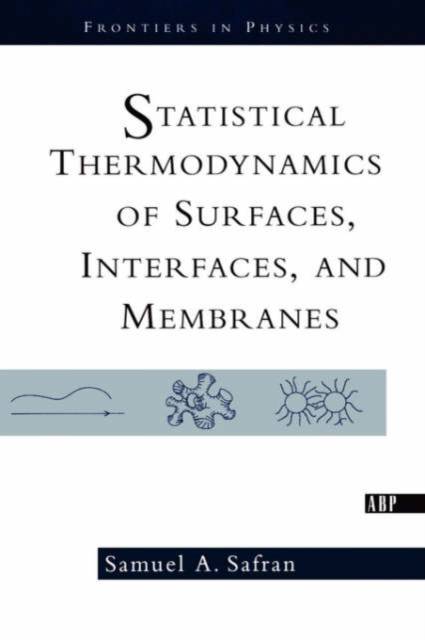
- Retrait gratuit dans votre magasin Club
- 7.000.000 titres dans notre catalogue
- Payer en toute sécurité
- Toujours un magasin près de chez vous
- Retrait gratuit dans votre magasin Club
- 7.000.0000 titres dans notre catalogue
- Payer en toute sécurité
- Toujours un magasin près de chez vous
Statistical Thermodynamics of Surfaces, Interfaces, and Membranes
Samuel Safran
Livre broché | Anglais
140,45 €
+ 280 points
Format
Description
Understanding the structural and thermodynamic properties of surfaces, interfaces, and membranes is important for both fundamental and practical reasons. Important applications include coatings, dispersants, encapsulating agents, and biological materials. Soft materials, important in the development of new materials and the basis of many biological systems, cannot be designed using trial and error methods due to the multiplicity of components and parameters. While these systems can sometimes be analyzed in terms of microscopic mixtures, it is often conceptually simpler to regard them as dispersions and to focus on the properties of the internal interfaces found in these systems. The basic physics centers on the properties of quasi-two-dimensional systems embedded in the three-dimensional world, thus exhibiting phenomena that do not exist in bulk materials. This approach is the basis behind the theoretical presentation of Statistical Thermodynamics of Surfaces, Interfaces, and Membranes. The approach adapted allows one to treat the rich diversity of phenomena investigated in the field of soft matter physics (including both colloid/interface science as well as the materials and macromolecular aspects of biological physics) such as interfacial tension, the roughening transition, wetting, interactions between surfaces, membrane elasticity, and self-assembly. Presented as a set of lecture notes, this book is aimed at physicists, physical chemists, biological physicists, chemical engineers, and materials scientists who are interested in the statistical mechanics that underlie the macroscopic, thermodynamic properties of surfaces, interfaces, and membranes. This paperback edition contains all the material published in the original hard-cover edition as well as additional clarifications and explanations.
Spécifications
Parties prenantes
- Auteur(s) :
- Editeur:
Contenu
- Nombre de pages :
- 284
- Langue:
- Anglais
Caractéristiques
- EAN:
- 9780813340791
- Date de parution :
- 29-01-03
- Format:
- Livre broché
- Format numérique:
- Trade paperback (VS)
- Dimensions :
- 152 mm x 229 mm
- Poids :
- 385 g

Les avis
Nous publions uniquement les avis qui respectent les conditions requises. Consultez nos conditions pour les avis.






